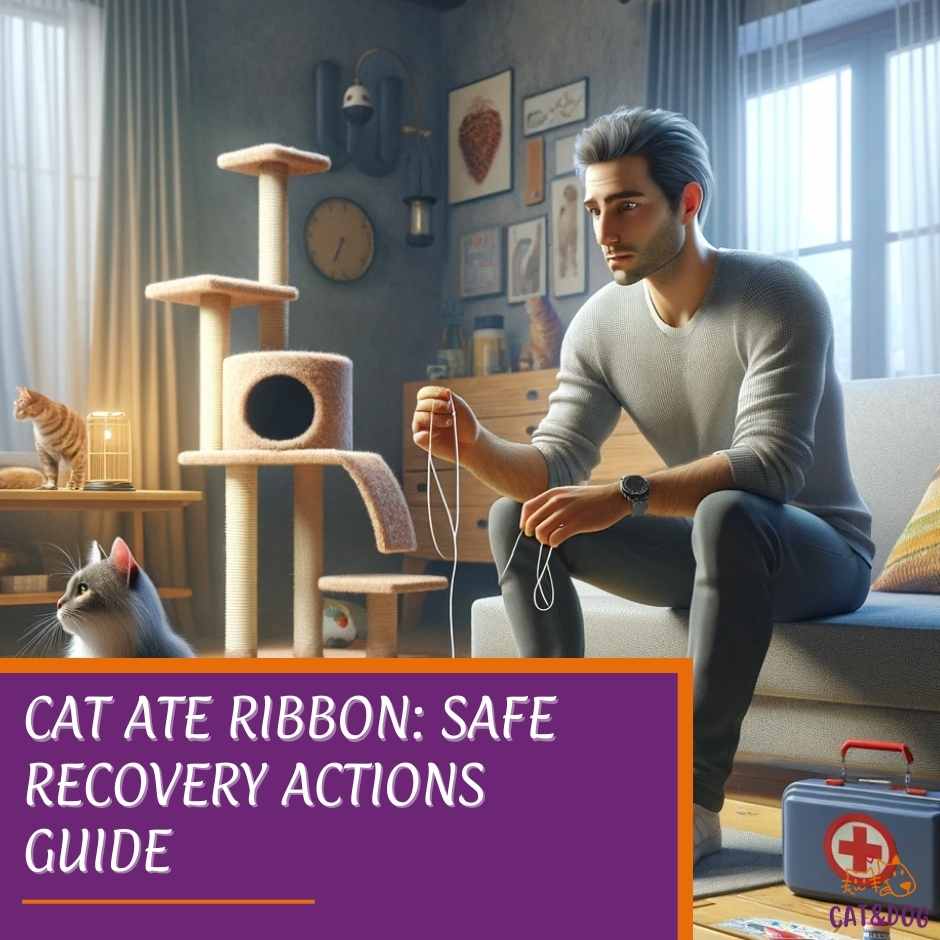Have you ever wondered why your cat ate ribbon?
It seems that no matter where you put them, they find their way into your cat’s paws—and sometimes their mouth.
While it’s cute to see your kitty play with a colorful ribbon, swallowing it can be dangerous, as it poses a choking hazard.
When a cat ingests plastic or ribbon, it can become a linear foreign body in the intestinal tract, with one end of the ribbon lodged somewhere in the GI tract and the rest trying to pass through.
This can lead to serious complications and is considered a veterinary emergency.
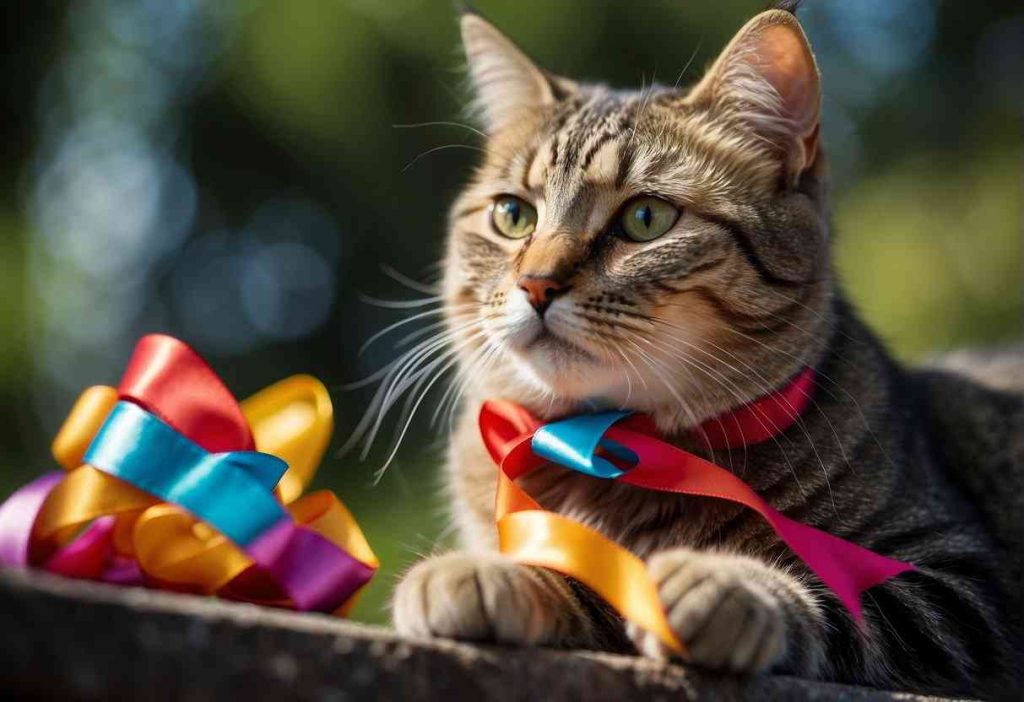
If you’ve caught your cat in the act of eating a ribbon, or if you suspect it has swallowed one, your immediate response can make a huge difference.
Keeping ribbons out of reach is an excellent preventive step, but knowing what signs to look for if ingestion occurs is also crucial.
Let’s dive into what to do if you find yourself in this hairy situation, no pun intended.
Contacting your vet immediately for advice and discussing diagnostic and treatment options is the best course of action to prevent it from becoming a foreign linear body in your cat’s gastrointestinal tract.
This includes monitoring your cat’s stool for the presence of the ribbon and seeking medical attention if necessary.
Never mind ribbons, even plants that are not dangerous for humans will also be very toxic for your cat, so as paw-rents, you better pay attention to what other cats eat.
Key Takeaways
- Cats may find ribbons irresistible, but swallowing them can lead to serious health issues.
- Immediate action is vital if a cat consumes ribbon to prevent potential linear foreign body complications.
- Preventing access to ribbons and similar items is key to ensuring your cat’s safety and long-term health.
Immediate Response and Veterinary Care
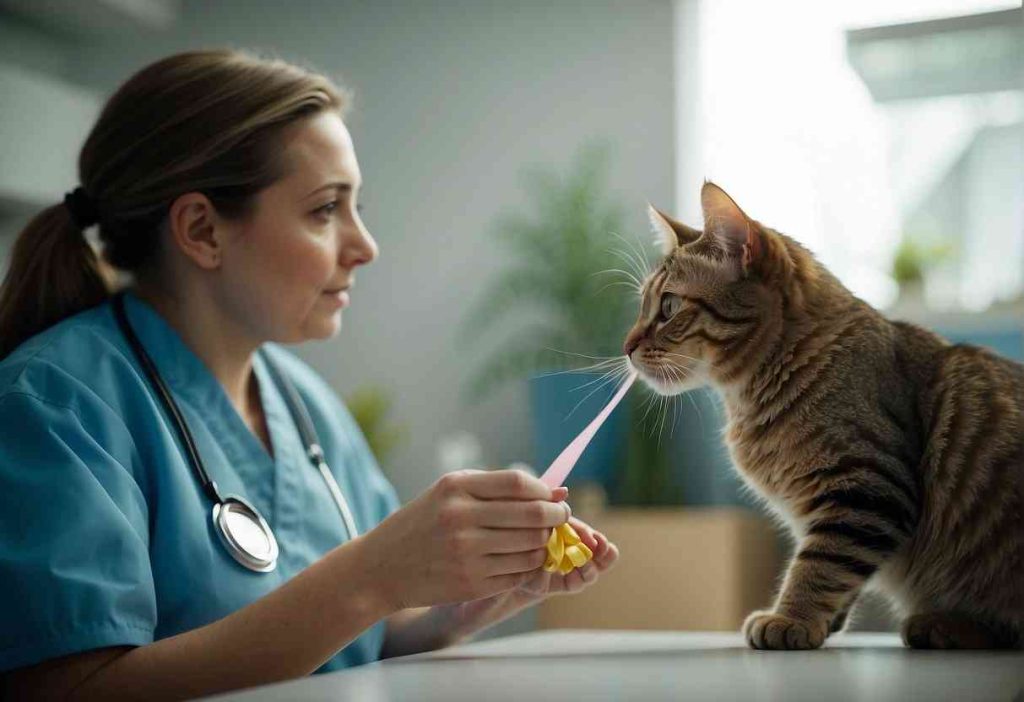
Urgent Veterinary Attention
Got those symptoms ticked? Speed dial your vet! Time is of the essence, and Mr. Whiskers needs urgent veterinary attention. Your vet might suggest an X-ray or an endoscopy to get a glimpse of what’s going on.
Picture it: These procedures could be the all-clear your cat needs or a life-saving discovery for surgical emergencies.
Case Study: A Narrow Escape
Quick story – a fellow cat lover like you had a scare when Luna, their tabby, munched on a shiny ribbon. After noticing Luna gagging and losing her appetite, they raced to the vet.
The vet performed an X-ray and confirmed the ribbon was causing trouble.
Thanks to an emergency endoscopy, a procedure using an endoscope, Luna was back to her playful self, all with a successful intervention.
This case study highlights the importance of monitoring your cat’s behavior and seeking immediate medical attention if they ingest something potentially harmful.
In this situation, a quick chat with a veterinarian and prompt action saved Luna’s life.
Remember, while Luna’s story had a happy ending, every second counts. If you’re in a similar bind, act fast and get your whiskered friend the help they need.
No dramatics here, just love, care, and timely action for your purring pal!
Long-Term Health and Safety Considerations
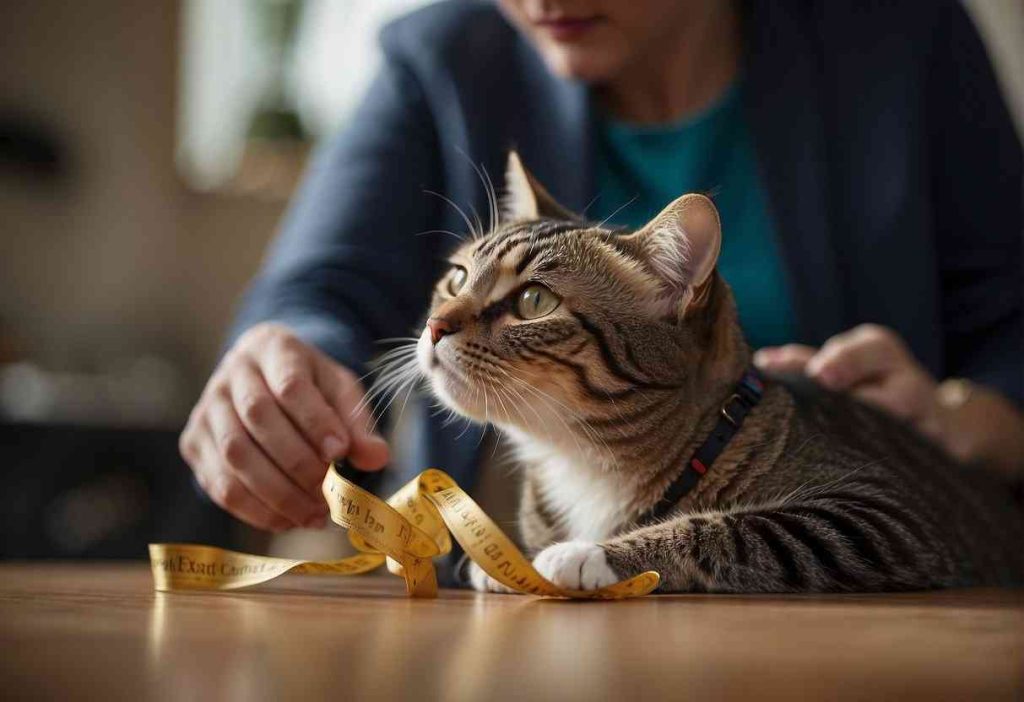
After your cat has ingested ribbon, monitoring their long-term health and safety becomes crucial because pieces of ribbon can lead to intestinal blockages, which are no joke and could even require surgery. (1)
The symptoms can vary—think vomiting, loss of appetite, or even bloody diarrhea. So, what should you look out for over time? (2)
Keep a close eye out for signs of distress such as vomiting, diarrhea, lack of appetite, or lethargy, as these could indicate a serious issue that requires immediate attention from an emergency vet. (3)
- Regular Check-Ups: Don’t skip those vet appointments. Your vet can keep an eye on any lingering effects and, if necessary, perform imaging tests to ensure nothing’s awry inside.
- Watchful Eyes: Sure, cats are independent, but they’ll need you to keep a lookout for any unusual behaviors or health concerns.
Ensuring ongoing safety can sound daunting, but it’s all about being proactive:
- Cat-proof Your Space: Store away ribbons, threads, and all those fascinating fiddly things. Think of it like baby-proofing but for your furry child.
- Training Time: Cats can be taught—really! Discourage interest in strings and similar items with positive reinforcements. Got a water sprayer? That might just become your best friend.
Tips for a Safe Environment:
- Keep ribbons out of reach (a no-brainer, right?).
- Secure trash cans, because we know how curious your cat can be.
- Introduce safe, stimulating toys—ones without any strings attached!
It’s not just the ribbon that you have to pay attention to the placement of because all items that shouldn’t be eaten by cats must be stored properly. Prevention is better than cure, paw-rents.
Remember, you’re not just a pet owner; you’re a pet protector. Keeping vigilant and making these small changes ensures a happy, healthy life for your whiskered companion.
It’s all about balance—prevention, awareness, and a scoop of love.
In-Depth Look at Ribbon and String Materials
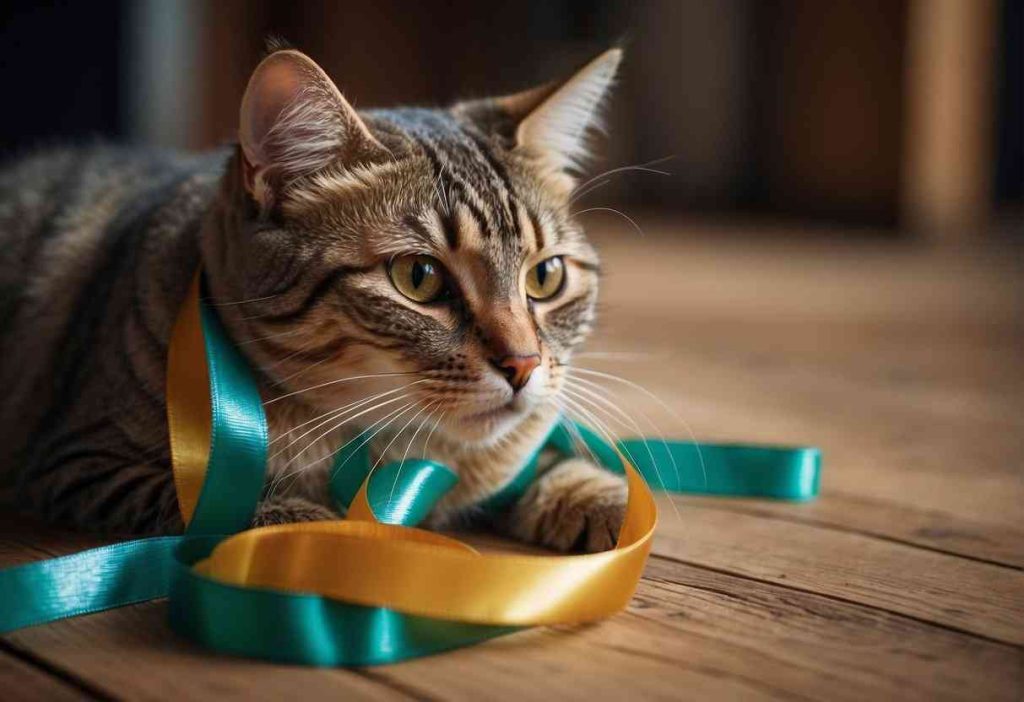
Types of Hazardous Materials
- Yarn: Cozy and often colorful, right? But it can cause knots in the digestive tract if ingested. (4)
- Plastic Ribbons: These might seem harmless, but if chewed on, they can lead to intestinal blockages.
Have you considered why these materials are tricky? Look at the risks they carry.
| Material | Risks |
| Yarn | Knotting inside intestines. |
| Plastic | Can cause blockages and toxins. |
| String | May cut through tissues. |
Risks Associated with Each Type Now, let’s talk numbers.
While I can’t give you exact statistics, I can tell you that gastrointestinal obstructions are among the top reasons cats end up in surgery – and items like ribbons and string are often the culprits.
Sure, they love to chase and chew on that shiny ribbon, but here’s the lowdown:
- Thin Strings or Dental Floss: Sharp as a ninja’s wire, they can slice through the intestines.
- Rubber Bands: Seem like a harmless office supply? Ingestion can lead to a rubbery mess inside!
- Thicker Ribbons: The wider they are, the more likely they can bunch up in your cat’s inside like an unwanted belt tightening around their middle.
Remember, a seemingly innocent game of chase can turn into a not-so-fun vet run. Keep your cat’s playtime safe by monitoring their toys and making sensible choices!
Behavioral Aspects and Preventive Measures to Your Cat Ate Ribbon
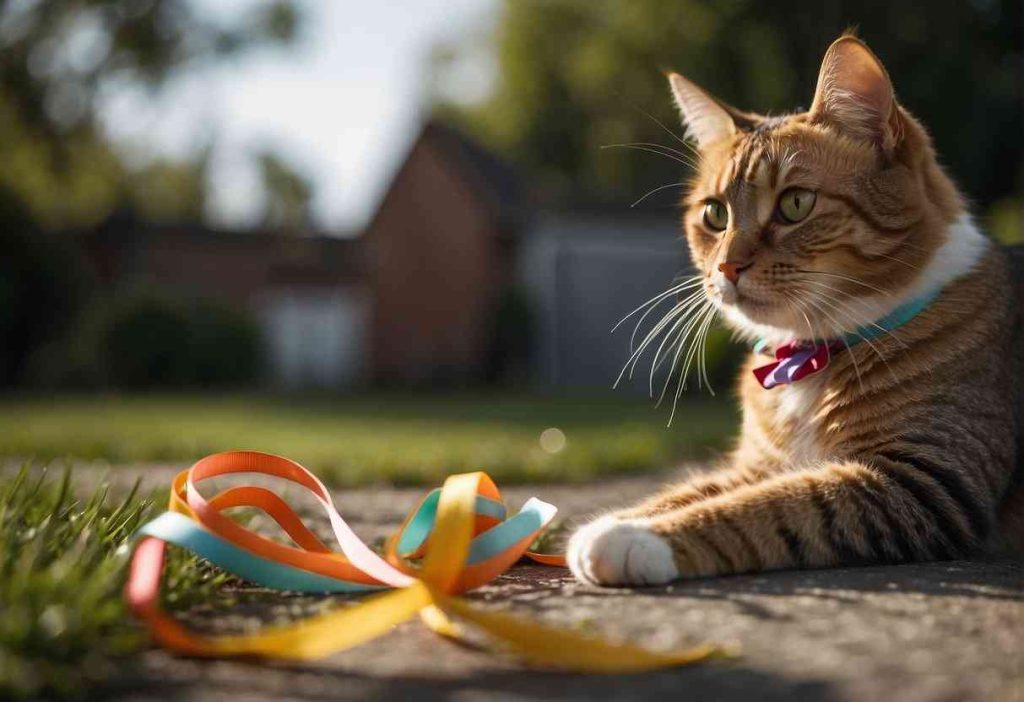
Ribbons mimic the movement of prey like snakes and worms, triggering your cat’s natural predatory instincts.
So, how can you discourage this dangerous habit? Let’s explore:
- Behavioral Modification: Use positive reinforcement to train your cat. Reward them with treats or affection when they play with appropriate toys.
- Safe Alternatives: Keep a variety of safe toys handy. Cats love variety, so switch things up to keep them interested.
Pro tip: Always supervise playtime with new toys to ensure they’re a hit!
Educating Your Household
Get everyone on board with your cat’s safety. It’s like a team sport – everyone needs to understand the risks of leaving ribbons within paw’s reach. Share stories and articles to highlight the importance of vigilance.
Quick Preventive Checklist:
- Inspect toys for wear and tear.
- Store ribbons and strings out of sight.
- Replace dangerous items with cat-specific toys.
Remember, you’re the goalie in this game of cat safety – your quick reflexes can prevent a trip to the vet!
Keep it fun, keep it safe, and enjoy the purrs and headbutts of a happy, healthy cat.
Case Studies and Personal Experiences
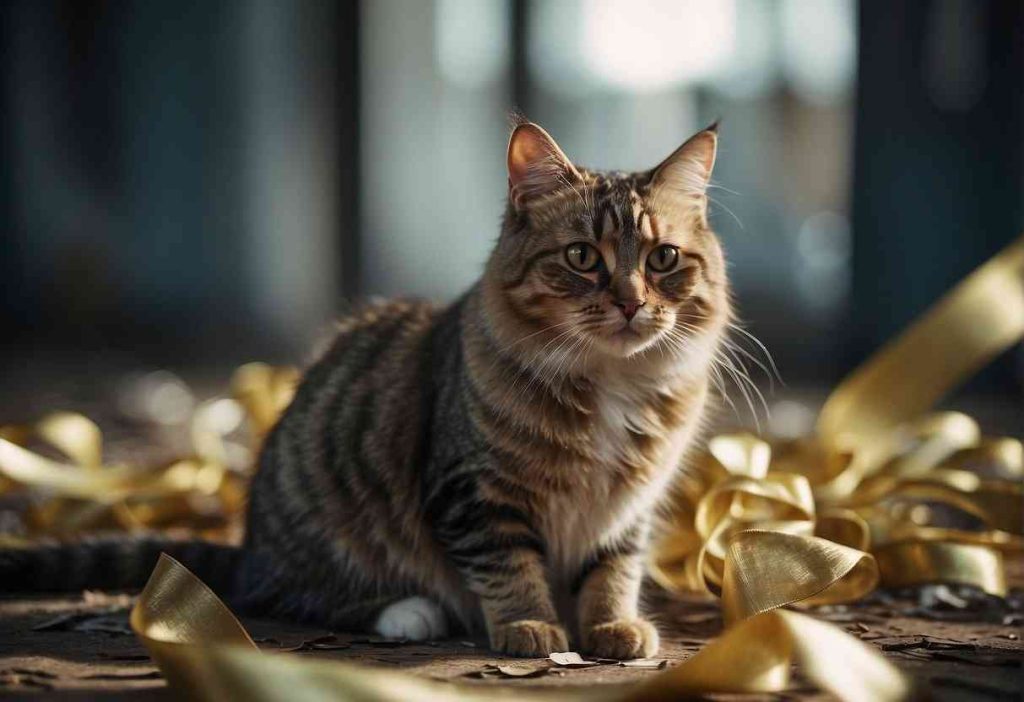
Veterinary Visits:
- Incident: A cat ingested an 18-inch ribbon.
- Outcome: The ribbon caused a blockage requiring surgical removal.
- Veterinary Advice: Any vomiting or changes in behavior post-ingestion should prompt an immediate vet visit.
Owner Anecdotes:
- Situation: A cat played with and swallowed a piece of ribbon.
- Reaction: The owner noticed vomiting and distress.
- Lesson: Keep potentially dangerous items like ribbons out of reach.
Remember, even if they manage to cough up a bit of what they ate, parts could remain inside and cause harm.
| Emergency Measures | Owner Feedback |
| Rushed to vet with string out | “Act fast and don’t wait, even if you’re not sure!” |
| Surgical intervention needed | “The peace of mind knowing your cat is safe is worth it.” |
| Watching for post-op recovery | “Keep an eye out for any odd behavior after they’re home.” |
Tips From Cat Owners:
- Always supervise your cat with play items.
- Regularly inspect toys for wear and tear.
- Educate yourself on what to do in emergencies.
And hey, a quick brush-up on pet first aid might just save a life. Your curious companion depends on you to keep their nine lives intact, so let’s make sure we’re up for the task, shall we?
Stay vigilant and keep sharing these stories—they could be a lifesaver for another kitty out there!
Quick Recap
Here’s what you need to know when your curious friends often nibble on things they shouldn’t like ribbon.
Immediate Steps:
- Stay Calm: Panicking won’t help your feline friend.
- No Pulling: If the ribbon is partly hanging out from their mouth, resist the temptation to pull it out to avoid internal injury.
- Vet Visit: Time is of the essence. Contact your vet right away.
Symptoms to Monitor:
Quick action is crucial. If the ribbon causes blockage and isn’t treated immediately, it can lead to serious health issues.
Long-Term Care:
- Monitor your cat’s behavior and feces for anything unusual.
- Follow your vet’s advice for care and any dietary adjustments.
Preventive Strategies:
- Keep ribbons and strings out of reach.
- Invest in safe, cat-friendly toys.
Remember, accidental ingestion of foreign objects can happen to the best of us. So keep a watchful eye on your feline and make your home as cat-safe as possible.
It’s all part of the fun and responsibility of being a cat owner! And hey, isn’t their health and happiness worth it?
Frequently Asked Questions
When your cat does something as worrying as eating a ribbon, you’re likely brimming with questions. Let’s clear up some of the confusion with straightforward answers to common concerns.
What are the first signs that my cat has eaten a ribbon?
If you notice your cat vomiting, showing signs of abdominal pain, or experiencing a loss of appetite, these could be red flags that they’ve swallowed a ribbon.
Be on the lookout for changes in behavior or any signs of discomfort.
How long after eating a ribbon should I wait before taking my cat to the vet?
Don’t wait; time is of the essence. If you suspect your cat has eaten a ribbon, contact your vet immediately for advice. Prompt veterinary care can be crucial.
Can a cat pass a ribbon naturally without intervention?
It’s risky to assume a cat can pass a ribbon without help. While it’s possible, ribbons can cause obstructions that might require surgical intervention.
It’s best to consult your veterinarian.
What treatments might a vet recommend if my cat eats a ribbon?
Your vet may suggest X-rays or an ultrasound to determine the severity of the situation.
Your vet may also suggest endoscopy, surgery, or supportive care depending on the specifics.
How can I prevent my cat from eating ribbons or similar objects again?
Keep ribbons and string-like items out of reach.
Offer safe alternatives for play, and supervise your cat’s activities, especially during holidays when such items are commonly within paws’ reach.
What should I do if I’m not sure whether my cat ate a ribbon?
Look for any possible evidence of ribbon ingestion and monitor your cat closely for symptoms. When in doubt, better safe than sorry—consult your vet.
Can eating a ribbon cause long-term health issues for my cat?
If not addressed promptly, ingesting a ribbon can lead to serious gastrointestinal issues or obstructions.
Sometimes resulting in long-term health complications or even life-threatening emergencies.

